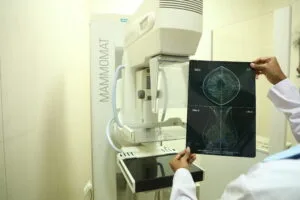Immunohistochemistry (IHC) Markers In Breast Cancer

Immunohistochemistry (IHC) is used for diagnostic problems with breast biopsies. IHC is also frequently used as prognostic and predictive tests.
| IHC Marker(s) | Purpose | Cell/ antigen/ protein targeted | Interpretation |
| ER, PR, Her2 | Predictive/ Theranostic | Hormonal markers | Immunohistochemical stains for ER, PR, and HER2 are performed for predictive and therapeutic information. |
| Ki-67 | Prognostic | Proliferative index marker | Used to determine the prognosis of breast cancer. Also seen in differentiating Phyllodes tumour – benign, borderline, and malignant. |
| P63, Calponin, SMA, S100, HMWCK (high molecular weight cytokeratin) | Diagnostic | Myoepithelial cells | The presence of myoepithelial cells (MECs) in an intimate relationship with the epithelial cells of the lesion determines the difference between in-situ and invasive disease and between benign pseudo-invasive lesions and invasive carcinoma. Also used to categorize various papillary lesions of the breast. |
| E-cadherin (ECAD) | Diagnostic | Cell adhesion molecule | Used to differentiate between lobular and ductal carcinoma.
|
| Cytokeratin, EGFR | Diagnostic | Basal-like carcinoma | Basal-like carcinomas are triple-negative and show immunoreactivity for basal cytokeratin and EGFR. |
| Cytokeratin | Diagnostic | Sentinel node metastasis | IHC for cytokeratin stains highlight isolated tumour cells (tumour cell aggregates ≤0.2 mm). |
| EMA, MUC-1 | Diagnostic | Micropapillary carcinoma | Identifying special types of breast carcinomas – micropapillary carcinomas can be confidently identified using EMA (or MUC-1), which demonstrates reverse. |
| CK7, GCDFP15, Mammaglobin, ER, CK20 | Diagnostic | Systemic metastasis of breast carcinoma | In cases of morphologically similar metastatic tumours, a panel of markers are used to confirm breast primary. |
| PDL-1 | Predictive/ Theranostic | Immune checkpoint inhibitor | In triple-negative breast cancer if cells have high expression of PDL1, then immunotherapy can be advised. |
Triple-Negative Breast Cancers (ER-negative, PR-negative, HER2-negative):
- Studies suggest that triple-negative breast cancers present aggressively with rapid growth and have a poorer prognosis compared with patients with other breast cancer subtypes.
- Triple-negative breast cancer is usually high grade, and the most common histology is infiltrating ductal carcinoma, although a rare histologic subtype, medullary carcinoma, is generally triple negative.
- While the triple-negative clinical phenotype is heterogeneous, the basal-like molecular subtype comprises a large proportion, particularly for BRCA1-associated breast cancer.
Suburban Diagnostics offers a complete range of IHC and molecular testing for the diagnosis and prognostication of all types of breast cancers.
For any queries, contact:
- Dr. Girish Anand Muzumdar
Consultant Histopathologist, Suburban Diagnostics
Email ID: girish.muzumdar@suburbandiagnostics.com
Ph: 022-4027-4569 / 70
- Dr. Ratika Agarwal,
HOD, Histopathology, Suburban Diagnostics
Email: drratika@suburbandiagnostics.com
Ph: 022-4027-4569 / 70
[post_date]
[Sassy_Social_Share]



